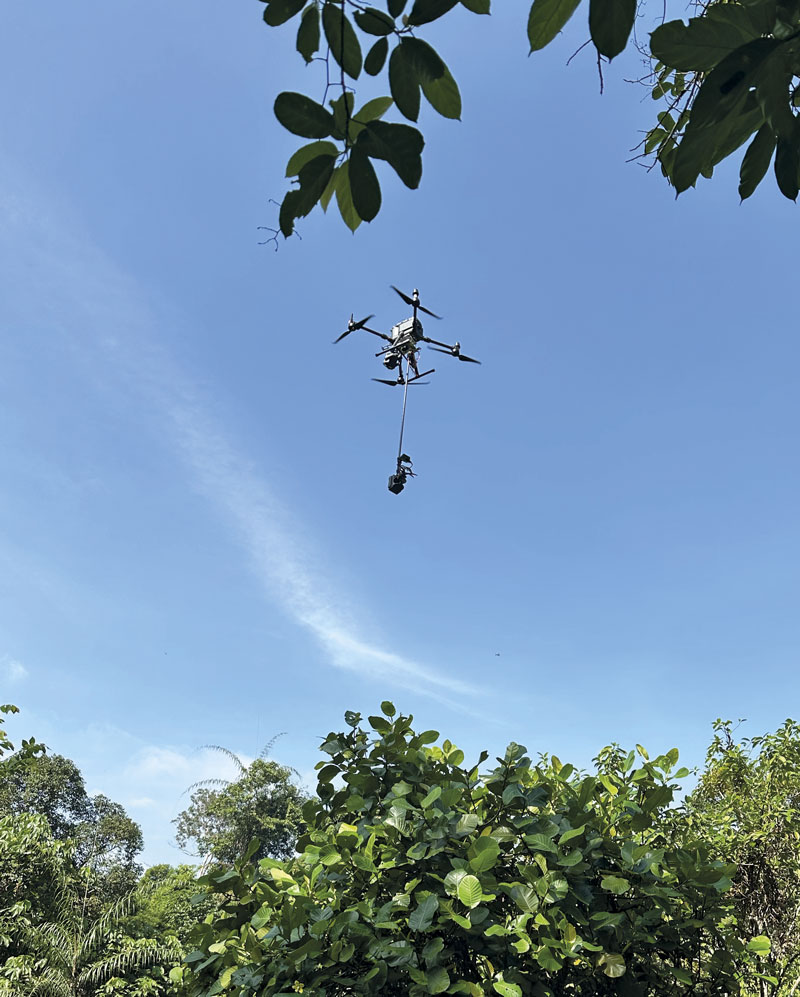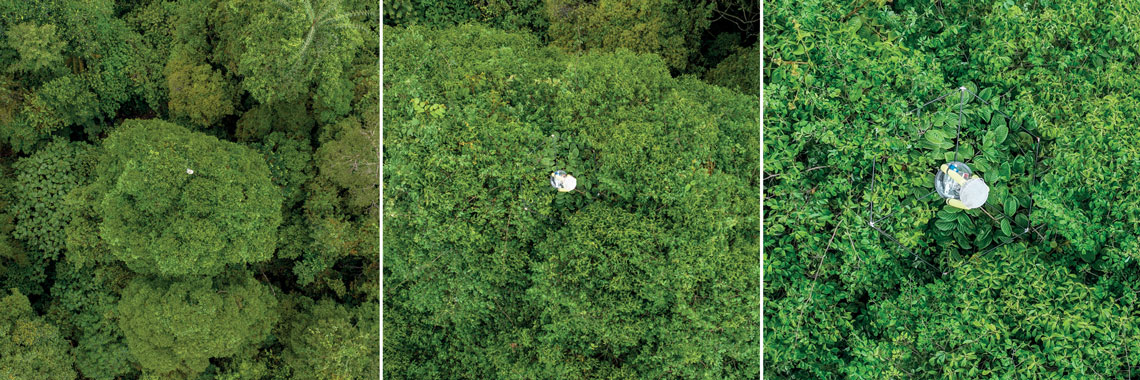A drone around 1 meter (m) in diameter flies over the canopy of a tropical rainforest. Then, it deposits a transparent acrylic dome on top of a tree with legs made of carbon fiber, as if they were spiders around 2 m in diameter. Inside, there are photographic cameras, sound recorders, and humidity, carbon dioxide (CO₂), and temperature sensors. Afterwards, the same flying device, equipped with two claws and a small round saw, cuts a piece of branch from the top of the tree and takes it to the team of researchers that control it near the forest. They also receive the images, sounds, and other data collected on their computers.
At the same time, other drones use radars to map the area by means of remote sensing and a small robotic car travels along the ground collecting samples. The arsenal gives an idea of what the Brazilian team, made up of 80 researchers and one of six finalists of the XPRIZE Rainforest, is preparing for the final of the competition, in July 2024. The mission: To collect the largest amount of data about the plant and animal species in a 100-hectare (ha) portion of the Amazon rainforest in 24 hours. And analyze everything in another 48 hours.
“While athletes around the world are in search of medals at the Paris Olympics, we will be competing to map the biodiversity of these hard-to-penetrate environments,” says biologist Simone Dena, of the University of Campinas (UNICAMP), bioacoustics coordinator for the Brazilian team. Some 300 researchers will represent the finalist teams in Amazonas: one group from Brazil, three from the USA, one from Spain, and another from Switzerland. The data and the exact location will be revealed closer to the time. First place will win US$5 million, second US$2 million, and third place US$500,000. At the end of the contest, the data will be shared in the GBIF and iNaturalist open-access databases.
“The objective is to encourage the development of autonomous technologies with rapid data integration that enable biodiversity mapping to be expanded and knowledge about the ecosystems of tropical forests to be improved,” says Brazilian Michelle Siqueira, who is part of the management team of the prize, organized by the XPRIZE Foundation, a North American nonprofit organization. The foundation manages awards aimed towards the acceleration of new technologies, like the private space race, and those aimed at global environmental and social challenges, such as cleaning oil spills in the sea, and monitoring the acidification of the oceans, among others.
Over the four years of the competition, 300 groups from 70 countries took part in the knockout phases of the contest and 15 teams reached the in-person semifinal in June 2023, when they put their equipment to the test for the first time on a fragment of forest in Singapore. On this occasion, the Brazilian team identified 209 species, including plants, amphibians, invertebrates, birds, and mammals. Each of the six teams selected for the final received around US$333,000. The Brazilian team has invested the amount on research scholarships, equipment, and will pay for a trip to Amazonas at the beginning of the year for more field tests.
“With more traditional techniques, we were unable to widely map and identify many species of plants and animals before a large part of them become extinct,” observes biologist Vinicius Castro Souza, of the Luiz de Queiroz College of Agriculture at the University of São Paulo (ESALQ-USP), in Piracicaba. “That’s why we consider the challenge important for accelerating this process and further developing means of making collections remotely, which means the fieldwork has fewer risks,” he adds.

Paulo Guilherme Molin - UFSCAR/CCN Lagoa do Sino
Adaptations to a small automated car and a spider-shaped structure could lead to patentsPaulo Guilherme Molin - UFSCAR/CCN Lagoa do SinoThe Brazilian Team contains mostly Brazilians, but includes members from other countries—Colombia, USA, France, Germany, Spain, Portugal, and the UK—and is divided into six subgroups: bioacoustics, robotics, remote sensing, DNA, biodiversity, and insights. These areas are organized through two parallel strategies, centered on the identification of visible (samples and images of animals and plants) and invisible biodiversity, using analyses of DNA samples from organisms present in the environment, the so-called environmental DNA (eDNA). The researchers also intend to count on the support of citizen science actions, involving the local community in the identification of species.
Adapted equipment
For the ground collections, a commercial robotic car around 1.5 m in length and 100 kilograms (kg) in weight was adapted with a series of additions. Besides cameras and sound recorders, a system collects and stores around 1 kg of plant litter with earth, leaves, branches and small insects. A ground drill makes 15-centimeter (cm) holes and a light trap attracts insects, such as mosquitoes.
By air, a drone was adapted to carry an acrylic dome, a hemisphere that houses the equipment against adverse weather conditions. In locations with an internet signal, computer panels enable information to be sent to a system in the cloud. “The dome was designed to be modular, which enables personalization of the equipment that it will carry,” explains electrical engineer Marco Terra, of the São Carlos School of Engineering (EESC-USP), coordinator of the team’s robotics area.
Another drone gained claws and a saw that allows it to cut and carry branches around 20 centimeters (cm) in length and that weigh on average 40 grams (g). The device, inspired by a Canadian initiative, was affectionately named the automatic pruner and proposes a solution for the difficulty of collecting samples from huge trees that grow in the Amazon. “Usually, to do this work, it is necessary to rely on climbers or launch a type of slingshot with fishing lines,” observes Terra. The apparatus still needs stability adjustments, as the researchers noticed when using it in the semifinal in Singapore.
In Terra’s assessment, of the equipment developed, the dome and the pruning claw would have more potential to become marketable products, as they are useful for fieldwork for a variety of research. “The dome, with this design, is our creation and its patent application has already been written. On the claw, we made adaptions for the reality of the tropical forest that also enables a patent application to be created,” says the engineer. According to him, one of the team’s objectives is to make some of the equipment, controlled remotely, to be autonomous—more details will only be known in the final.
Environmental DNA and artificial intelligence
The collected plant and animal material has to be screened and analyzed by taxonomists with the help of software. Part of it goes to the mobile laboratory for genetic analysis. The researchers use portable sequencers, the size of tablets, that can be connected to a computer.
 Paulo Guilherme Molin - UFSCAR/CCN Lagoa do Sino“Doing the sequencing in the field is complicated. We are making adjustments in the protocols to make them more efficient, in partnership with the manufacturers themselves, because this equipment was developed for longer DNA sequences than we are able to achieve with the environmental DNA,” explains biologist Carla Martins Lopes, of the São Carlos campus of USP, coordinator of the DNA team.
Paulo Guilherme Molin - UFSCAR/CCN Lagoa do Sino“Doing the sequencing in the field is complicated. We are making adjustments in the protocols to make them more efficient, in partnership with the manufacturers themselves, because this equipment was developed for longer DNA sequences than we are able to achieve with the environmental DNA,” explains biologist Carla Martins Lopes, of the São Carlos campus of USP, coordinator of the DNA team.
Other intangible information about biodiversity should be collected and processed with the help of software with artificial intelligence to accelerate the biodiversity identification process. With the drones for remote sensing, there are three strategies. The first is obtaining images with the Light Detection and Ranging (LIDAR) technique, which uses pulsed lasers that, once reflected by the trees, enable the mapping of the forest structure, such as the relief and height of the vegetation, as well as the carbon stocks. “The second consists of creating high resolution maps of the tree canopies, which we use to train a species recognition algorithm similar to the one that does the facial recognition systems,” says forestry engineer Danilo Roberti Alves de Almeida, one of the directors of the startup BRCarbon Climate Tech and coordinator of the remote sensing subgroup, together with environmental manager Paulo Guilherme Molin, of the Federal University of São Carlos (UFSCar). The third strategy uses autonomous drones, with optical zoom sensors, to take high-resolution photographs of vegetation for later identification by artificial intelligence.
Another algorithm, capable of recognizing the sounds of animals, such as birds, amphibians, bats, and insects, is also under development. It is being trained with the public database of the Jacques Vielliard Neotropical Sound Library (FNJV) of the Museum of Biological Diversity of UNICAMP, which holds approximately 81,000 records. “We are in contact with researchers from the Amazon to collect more animal sounds from the region and expand the collection, which will be used for our software,” explains biologist Luís Felipe Toledo, of UNICAMP, one of the coordinators of the bioacoustics group. The idea is to make the software available via open access.
The other five teams are also in the race to develop drones, autonomous robots, aerial platforms, and artificial intelligence systems that enable the collection and identification of species in a more automated fashion and as quickly as possible. “The proposal of the Brazilian team’s protocol, which uses drones, collection robots, and DNA data processing, all integrated, seems promising to accelerate the activities of collecting species in these environments,” assesses biologist Fabiano Rodrigues de Melo, of the Federal University of Viçosa (UFV), who is not participating in the competition. Since 2017, he has been using drones and artificial intelligence programs to identify muriquis in the forests of Minas Gerais.
“Tropical forests are home to the greatest biodiversity on the planet, and this diversity is still little known, especially in the Amazon rainforest, with its continental dimensions,” says agricultural engineer Simone Aparecida Vieira, of UNICAMP, a member of the coordination of FAPESP’s Biota Program. She observes that traditional methods of collecting biodiversity demand a huge effort of time and people, so using cutting-edge technology to identify species in these locations could help in conservation policies. “The award brings this challenge to the present, encouraging bold ideas to expand our knowledge about biodiversity, something that the Biota program has also been encouraging since its creation, in 1999, and that is stressed in its strategic planning for the 2020–2030 period,” she contemplates.
The funding of the award, a total value of US$10 million, comes from the Alana Foundation, linked to the Alana Institute, a Brazilian nonprofit organization that promotes actions for protecting the rights of children and adolescents. “We made contact with XPRIZE and made them think about something aimed at solutions for the Global South, and they came to the conclusion that the loss of species in tropical forests was an urgent topic,” says Pedro Hartung, executive director of the foundation. “If our objective is to protect children, we need to guarantee that they have a sustainable world where they can grow up. And this includes initiatives that help to find alternatives for preserving our biodiversity,” he concludes.
Projects
1. From natural history to the conservation of Brazilian amphibians (nº 22/11096-8); Grant Mechanism Thematic Project; Principal Investigator Luis Felipe de Toledo Ramos Pereira (UNICAMP); Investment R$1,656,574.79.
2. Understanding restored forests for the benefit of people and nature – NewFor (nº 18/18416-2); Grant Mechanism Thematic Project; Program Biota; Agreement Dutch Research Council (NWO); Principal Investigator Pedro Henrique Santin Brancalion (USP); Principal Investigator abroad Franciscus Johannes Jozef Maria Bongers (Wageningen University & Research, Netherlands); Investment R$1,659,863.08.
3. Restoration of native vegetation in the Atlantic Forest through a strategic combination of mandatory measures and voluntary commitments ‒ CCD-EMA (nº 21/11940-0); Grant Mechanism Research Grant ‒ Science for Development Centers; Principal Investigator Paulo Guilherme Molin (UFSCar); Investment R$355,136.76.
